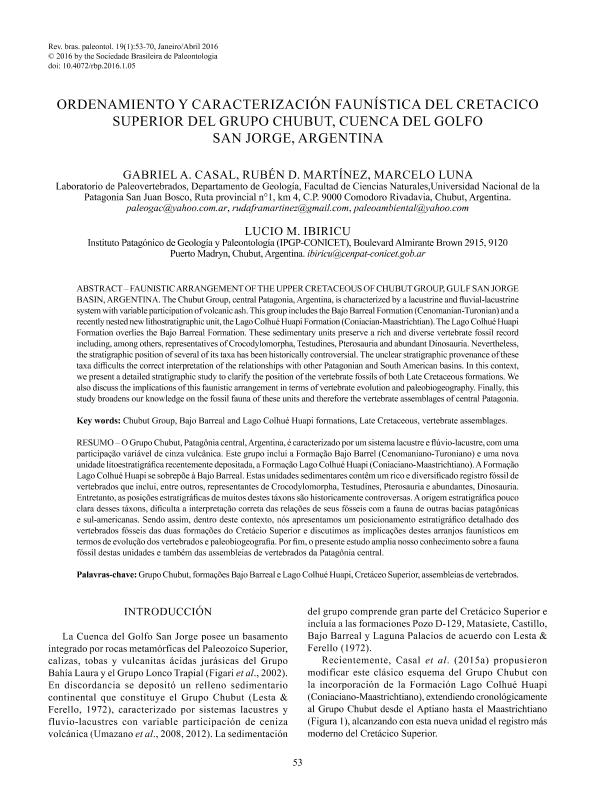Artículo
The Chubut Group, central Patagonia, Argentina, is characterized by a lacustrine and fluvial-lacustrine system with variable participation of volcanic ash. This group includes the Bajo Barreal Formation (Cenomanian-Turonian) and a recently nested new lithostratigraphic unit, the Lago Colhué Huapi Formation (Coniacian-Maastrichtian). The Lago Colhué Huapi Formation overlies the Bajo Barreal Formation. These sedimentary units preserve a rich and diverse vertebrate fossil record including, among others, representatives of Crocodylomorpha, Testudines, Pterosauria and abundant Dinosauria. Nevertheless, the stratigraphic position of several of its taxa has been historically controversial. The unclear stratigraphic provenance of these taxa difficults the correct interpretation of the relationships with other Patagonian and South American basins. In this context, we present a detailed stratigraphic study to clarify the position of the vertebrate fossils of both Late Cretaceous formations . We also discuss the implications of this faunistic arrangement in terms of vertebrate evolution and paleobiogeography. Finally, this study broadens our knowledge on the fossil fauna of these units and therefore the vertebrate assemblages of central Patagonia. O Grupo Chubut, Patagônia central, Argentina, é caracterizado por um sistema lacustre e fluvio-lacustre, com uma participação variável de cinza vulcânica. Este grupo inclui a Formação Bajo Barrel (Cenomaniano-Turoniano) e uma nova unidade litoestratigráfica recentemente depositada, a Formação Lago Colhué Huapi (Coniaciano-Maastrichtiano). A Formação Lago Colhué Huapi se sobrepõe à Bajo Barreal. Estas unidades sedimentares contém um rico e diversificado registro fóssil de vertebrados que inclui, entre outros, representantes de Crocodylomorpha, Testudines, Pterosauria e abundantes Dinosauria. Entretanto, as posições estratigráficas de diversos destes taxa são historicamente controversas. A origem estratigráfica pouco clara desses táxons, dificulta a interpretação correta das relações de seus fósseis com a fauna de outras bacias patagônicas e sul-americanas. Sendo assim, dentro deste contexto, nós apresentamos um posicionamento estratigráfico detalhado dos vertebrados fósseis das duas formações do Cretácio Superior, bem como discutimos as implicações destes arranjos faunísticos em termos de evolução dos vertebrados e paleobiogeografia. Por fim, o presente estudo amplia nosso conhecimento sobre a fauna fóssil destas unidades e também das assembléias de vertebrados da Patagônia central.
Ordenamiento y caracterización faunisitica del Cretacico superior del Grupo Chubut, Cuenca del Golfo San Jorge, Argentina
Título:
Faunistic arrangement of the upper cretaceous of Chubut group, Gulf San Jorge Basin, Argentina
Fecha de publicación:
04/2016
Editorial:
Sociedade Brasileira de Paleontologia
Revista:
Revista Brasileira de Paleontologia
ISSN:
1519-7530
e-ISSN:
2236-1715
Idioma:
Español
Tipo de recurso:
Artículo publicado
Clasificación temática:
Resumen
Archivos asociados
Licencia
Identificadores
Colecciones
Articulos(CCT-CENPAT)
Articulos de CTRO.CIENTIFICO TECNOL.CONICET - CENPAT
Articulos de CTRO.CIENTIFICO TECNOL.CONICET - CENPAT
Citación
Casal, Gabriel; Martínez, Rubén Darío; Luna, Carlos Marcelo; Ibiricu, Lucio Manuel; Ordenamiento y caracterización faunisitica del Cretacico superior del Grupo Chubut, Cuenca del Golfo San Jorge, Argentina; Sociedade Brasileira de Paleontologia; Revista Brasileira de Paleontologia; 19; 1; 4-2016; 53-70
Compartir
Altmétricas




